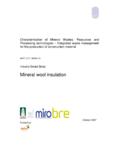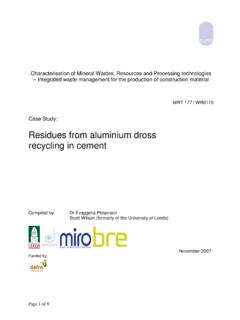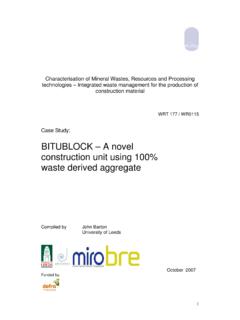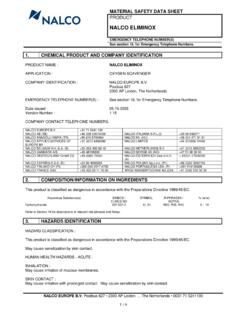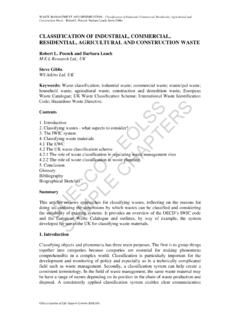Transcription of Plasterboard FGD gypsum - SMARTWaste
1 Page 1 of 8 Characterisation of Mineral Wastes, Resources and Processing technologies Integrated waste management for the production of construction material WRT 177 / WR0115 Case Study: Flue gas desulphurisation (FGD) gypsum in Plasterboard manufacture Compiled by Dr Andrew M Dunster BRE Funded by: November 2007 Page 2 of 8 Introduction This case study describes the potential and current use of flue gas desulphurisation (FGD) gypsum as an ingredient in the manufacture of Plasterboard . The study focuses mainly on FGD gypsum derived from coal-fired power stations but other sources of secondary and recycled gypsum are also mentioned. FGD gypsum is also commonly known as desulphogypsum (DSG). Sample of FGD gypsum (courtesy of the American Coal Ash Association) {low res image} Potential applications of FGD gypsum There is a strong demand for FGD gypsum for use in Plasterboard manufacture. Nevertheless, it is possible to use by-product gypsum for any of the purposes for which natural gypsum is used.
2 Other potential uses include use as a set controller in cement manufacture or in the manufacture of anhydrite floor screeds, building plasters, in road construction or in fertilizer production (1). Plasterboard industry and manufacture The domestic, commercial and industrial construction sectors all use Plasterboard . In the domestic sector, the use of Plasterboard in housing is increasing as construction companies move away from brick framed buildings to timber and steel framed buildings (dry-lined plaster which has been the trend in the USA for the last 15 years). Instead of bricks screened with wet plaster, the current trend is to build the frame in timber or steel, fill the cavity with insulation and seal it internally with Plasterboard . The performance characteristics of Plasterboard are said to make it particularly suitable for use in situations requiring fire protection and sound insulation. It is used extensively in domestic and commercial buildings as an internal lining for walls, internal partitioning within Page 3 of 8 buildings and as a ceiling and roof lining material.
3 Sources of calcium sulphate currently utilised in the manufacture of Plasterboard come from mines, synthetic gypsum (desulphogypsum) from power plants, post-industrial scraps and a very small percentage from post-consumer construction projects. Substantial amounts of synthetic gypsum (FGD gypsum ) sourced since 1994, contributed significantly to the decline of mined gypsum . The main UK manufacturers of Plasterboard are Knauf, British gypsum and Lafarge Plasterboard . Plasterboard manufacture utilises natural gypsum , FGD gypsum , recycled paper, production waste gypsum and minor fillers such as vermiculate and china clay. There may be scope for alternative sources of these fillers. The use of alternative raw materials in Plasterboard manufacture Plasterboard manufacturers are increasingly utilising flue gas desulphurisation (FGD) gypsum in their production. They also operate take back schemes, to recycle post-consumer waste into the production process There is little scope or interest in sourcing by-product gypsum from sources other than power station FGD, take-back schemes and recycled process waste as there is a plentiful supply of these.
4 The FGD gypsum is extremely pure and often additional ingredients (such as clays) are required as minor constituents. The manufacturers may be willing to consider alternative sources of minor ingredients (such as clays) that meet their specifications (they currently use finely divided china clay and microfine un-exfoliated vermiculite for this purpose). The behaviour of the Plasterboard industry regarding the use of alternative materials can be summarised in the following: o The industry is already utilising FGD gypsum , customers off-cuts and their own production waste in Plasterboard production o There is no driver to use other sources of gypsum o Manufacturers may be willing to consider other sources of minor ingredients o Plans to site manufacturing facilities alongside sources of FGD gypsum are already in hand o In Plasterboard manufacture, there is no need or incentive to use mineral wastes, with the exception of FGD gypsum which is already heavily utilised by the main producers.
5 waste exchange- FGD gypsum As a result of their own environmental policies, the Plasterboard manufacturers are actively utilising FGD gypsum . There is little scope for gypsum from sources other than power station FGD and recycled process waste as there is a plentiful supply. They may consider alternative sources of minor ingredients that meet their specifications (they currently use finely divided china clay and Page 4 of 8 microfine un-exfoliated vermiculite). In Plasterboard manufacture, there is no need or incentive to use other mineral wastes, with the exception of FGD gypsum which is already heavily utilised by the main producers. The Plasterboard manufacturers actively encourage recycling and take back Plasterboard waste from their customers, which are then returned into their process. Lafarge Plasterboard is seeking planning permission to develop a new Plasterboard manufacturing and distribution facility adjacent to the FGD plant that is to be built at Ferrybridge C Power Station.
6 It is expected that this example of industrial symbiosis will utilise more than 200,000 tonnes of synthetic gypsum a year (2). Barriers and Benefits 1. Contribution to the end product: FGD gypum is used as a substitute for natural gypsum in the manufacture of gypsum Plasterboard . It can be used as a complete substitution for the natural material. 2. Potential benefits: Material related i. Higher purity than most UK natural sources Economic ii. Gate fee (benefit to Plasterboard manufacturer) iii. FGD gypsum in UK costs much less than imported raw materials Environmental i. Preservation of natural resources, ii. Recycling of combustion residues Organisational i. Widely available in significant tonnages ii. Single large sources have high potential for industrial symbiosis arrangements 3. Potential barriers: Material related i. Handling and storage ii. Energy associated with drying the material for processing Legal i. FGD gypsum is currently defined as a waste .
7 Environmental i. Desulphurisation process/lime manufacture liberates carbon dioxide Page 5 of 8 Organisational ii. Public perception of waste iii. Long term coal fired power generation uncertain (3) 4. Analysis requirements: Analysis on alternative materials: mineralogy; particle size analysis; moisture content FGD gypsum FGD gypsum results from the emissions cleaning process known as flue gas desulphurisation (FGD), at coal fired electricity generating stations. This cleaning of flue gases is carried out using a finely ground limestone (or lime) which reacts with sulphur dioxide emissions to produce a very pure gypsum . The synthetic gypsum has a higher purity, 96% gypsum , than natural gypsum , typically 80% gypsum although higher purity natural gypsum does occur in England. The primary aim of this is to reduce acid precipitation from the atmosphere. Details of the different types of cleaning processes are given in reference (4). The desulphurisation process produces carbon dioxide.
8 The reaction taking place in wet scrubbing using a CaCO3 (limestone) slurry produces CaSO3 (calcium sulphite) and can be expressed as: CaCO3 (solid) + SO2 (gas) CaSO3 (solid) + CO2 (gas) Other sources of by-product gypsum are available. The main examples of these are titanogypsum and fluorogypsum. The annual production of the three main types of by product gypsum is given in Table 1. Table 1: Sources of by-product gypsum (source WRAP, 2006)(5) Type of by-product gypsum Current utilisation Current UK production (Million tonnes per annum) FGD gypsum (from removal of sulphur dioxide from flue gases of coal-burning power stations using FGD) Virtually all sold on for use in Plasterboard or related products Titanogypsum (from TiO2 pigment production) Majority utilised in Plasterboard or landspreading Fluorogypsum (from the manufacture of hydrofluoric acid Used in cement and floor screed Page 6 of 8 The three main manufacturers of Plasterboard in the UK all use FGD gypsum in their manufacturing process (6,7,8).)
9 They also use a proportion of post-industrial scrap and post-consumer Plasterboard . The main power stations currently producing FGD gypsum currently in the UK (October 2007)(9), are: - Ratcliffe, Nottinghamshire - West Burton, Nottinghamshire - Drax, Yorkshire - Cottam, Nottinghamshire - Eggborough, Humberside. Rugeley (Staffordshire) is currently being fitted with an FGD system. There is a potential to fit FGD systems to at least five other UK stations. WRAP estimates a potential total UK production of approximately million tonnes per annum if all these supplies were to come on-stream (5). It is reported that British gypsum owns exclusive rights to buy all the FGD gypsum from three stations (Ratcliffe, West Burton and Drax). Lafarge Plasterboard intend to submit a planning application seeking permission to develop a new Plasterboard manufacturing and distribution facility adjacent to the FGD plant that is to be built at Ferrybridge C Power Station (10). In the short to medium term, supplies of synthetic gypsum will increase as there are FGD plant installations planned at several more coal-fired power stations.
10 There is a high potential for the utilisation of FGD gypsum in construction products as: High volumes of FGD gypsum are currently available, with more material coming on stream. FGD gypsum is a consistent material of high purity due to high controls in the plants. As the collection of post-consumer and post-industrial Plasterboard waste becomes better developed, this may make more synthetic gypsum available for other applications. Documents produced by DEFRA s Market Transformation Programme and the British Geological Survey provide usefull background on the Plasterboard industry, market and sources of primary and secondary gypsum (7, 8). The gypsum Products Development Association is also a useful source of information (9). Page 7 of 8 Specific materials characterisation results for FGD gypsum Characterisation framework for Plasterboard ingredients Plasterboard manufacturers will each have their own acceptance criteria for alternative raw materials (synthetic gypsum and minor ingredients), which are company-specific and will be very tightly defined.

